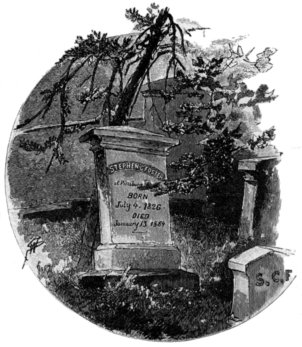
STEPHEN C. FOSTER.
in their tripartite nature to a big irregular Y. But no such simile
would hold good in considering her appearance on a railway map. Given an
evil-minded boy, a small round stone, and a plate-glass window, and
the natural result would be a counterpart of such a map. The hole
in the pane would, big or little, represent the City of Smoke, and each
diverging crack would stand for a railway that is loading or unloading its
traffic within her gates. At Union Dépôt—the building
recently erected over the ashes left by the terrible railroad riots of
three summers ago—the following lines come to a focus: the main
line of the perfectly appointed Pennsylvania Central; the Pittsburgh,
Fort Wayne, and Chicago, leading westwardly to the city by the lake; the
queerly named "Pan-Handle," or Pittsburgh, Cincinnati, and St. Louis,
leading across the "handle" of West Virginia, and so toward the setting
sun and the
|
city of music festivals and of much pork; the Allegheny Valley, winding north
along the beautiful river, and taking passengers "through by daylight"
to Buffalo; the Pittsburgh, Virginia, and Charleston, young and growing
southwardly up the Monongahela; the Southwest Pennsylvania at Greensburg,
and leading southwardly toward the border of the State; the Cleveland
and Pittsburgh, leading west through Northern Ohio to the Forrest
City; and the Erie and Pittsburgh, leading north to Erie at the remote
north-western corner of the commonwealth—eight busy roads that bring
into and take out of Union Dépôt 144 passenger trains daily.
At another dépôt is the terminus of the Pittsburgh division
of the Baltimore and Ohio road, joining the main line at Cumberland,
Maryland, by way of the Monongahela and Youghiogheny valleys. At the
base of Mount Washington, or Coal Hill, three more dépôts
are found. Chief among this trio is the Pittsburgh and Lake Erie,
leading west along the south bank of the Ohio River, and into the
State of that name, a "missing link" recently found, and none too soon,
as its construction gave Pittsburgh independence.

GRAVE OF STEPHEN C. FOSTER.
|